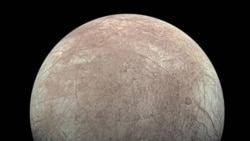The American space agency NASA has cleared a spacecraft to launch next month to look for possible signs of life on Jupiter’s moon Europa.
Agency officials announced plans for the Europa Clipper spacecraft at a press briefing last week. The launch window for the mission will open October 10. The spacecraft is to launch from NASA’s Kennedy Space Center in Florida. It will be carried to space aboard a Falcon Heavy rocket built by SpaceX.
The main goal of the mission is for the spacecraft to collect data on whether Jupiter’s icy moon could possibly support life. Scientists have identified Europa as a good candidate for holding the right conditions to support life. Several studies have suggested it likely contains a very large ocean beneath its icy surface.
In an online description, NASA says liquid water is necessary for planets or moons to support the “complex chemistry” processes that can make life possible. A huge, salty ocean likely lies beneath Europa’s surface and could hold “more water than Earth’s oceans combined,” the space agency added.
Scientists have also discovered evidence of chemical compounds and energy forces – including very strong gravity – that could provide the right conditions to support life.
Europa is a little smaller than Earth’s moon but is still one of the largest moons in our solar system. It is one of many moons orbiting Jupiter. Astronomers announced in 2023 they had discovered 12 additional moons orbiting Jupiter. NASA says the planet now has a total of 95 confirmed moons.
It is estimated to take six years for the robotic, solar-powered spacecraft to reach Europa. The orbiter is the largest spacecraft built by NASA to investigate another planet. It reaches about 30 meters when fully open. The orbiter is expected to perform many flybys of Europa. Some may get as close as 25 kilometers away from the moon.
After launching, NASA says Europa Clipper will fly past Mars, then back toward Earth, “using the gravity of each planet to increase its momentum.” These kinds of “gravity assists” are expected to provide the needed push to get the spacecraft to Jupiter by 2030.
After reaching Jupiter, Europa Clipper will then spend about one year preparing for the flybys of Europa.
NASA says the spacecraft is equipped with nine different scientific instruments. They are designed to collect data from all areas of the moon. None of the instruments themselves were built with the ability to confirm the existence of life forms. But they are designed to investigate Europa’s icy surface and the composition of the moon’s underground ocean for signs of possible life.
Team leaders say Europa Clipper will also use several cameras – including two using infrared technology – to map the moon in greater detail than in the past. Radar technology will also be used to collect data on the moon’s interior and to measure gravity. Together, the instruments and cameras will seek information about Europa’s current and past chemistry and geology.
Gina DiBraccio is the acting director of NASA’s planetary science division in Washington. She told the press briefing the agency is pleased to finally be moving the mission forward after years of planning and preparation. “As an ocean world, Europa is very intriguing. And this mission is going to help us to understand a complex piece of our solar system.”
Jordan Evans is Europa Clipper’s project manager. He said the last part of the preparation process involved testing of electronic transistors widely used on the spacecraft. His team wanted to make sure the transistors could survive the large amounts of radiation Europa Clipper is expected to be hit with in space.
After the tests, Evans said mission leaders were persuaded that the transistors could recover from the effects of heavy radiation during breaks from flybys of the moon. He said this meant all elements of the mission should be able to be carried out as planned.
Evans added, “We are ready for Jupiter.”
I’m Bryan Lynn.
Bryan Lynn wrote this story for VOA Learning English, based on reports from NASA and The Associated Press.
________________________________________
Words in This Story
momentum – n. the force that makes something continue to move
geology – n. the study of rocks and soil and the physical structure of Earth
intriguing – adj. very interesting
transistor – n. a small piece of electrical equipment used in radios, televisions, etc.










Forum